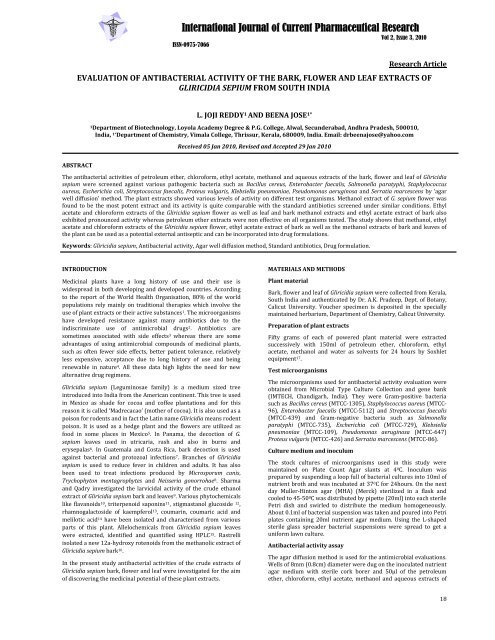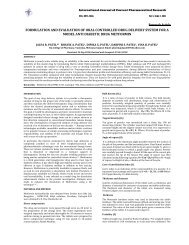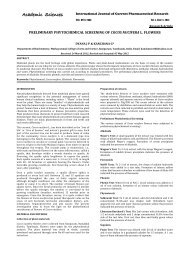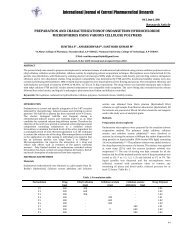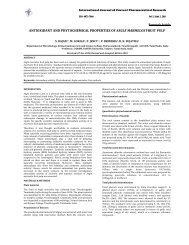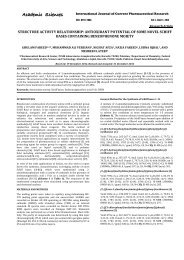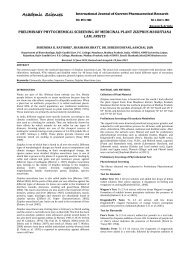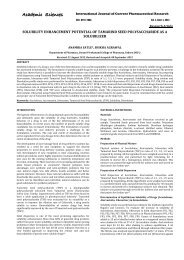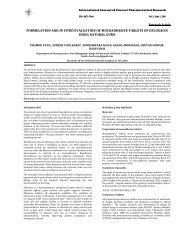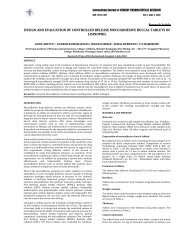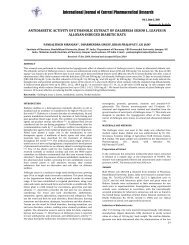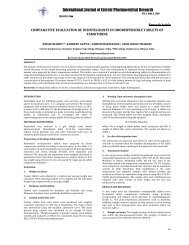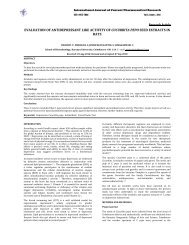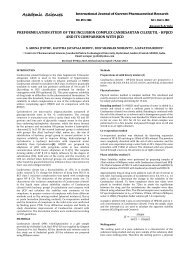evaluation of antibacterial activity of the bark, flower and leaf extracts ...
evaluation of antibacterial activity of the bark, flower and leaf extracts ...
evaluation of antibacterial activity of the bark, flower and leaf extracts ...
Create successful ePaper yourself
Turn your PDF publications into a flip-book with our unique Google optimized e-Paper software.
International Journal <strong>of</strong> Current Pharmaceutical Research<br />
Vol 2, Issue 3, 2010<br />
ISSN-0975-7066<br />
Research Article<br />
EVALUATION OF ANTIBACTERIAL ACTIVITY OF THE BARK, FLOWER AND LEAF EXTRACTS OF<br />
GLIRICIDIA SEPIUM FROM SOUTH INDIA<br />
L. JOJI REDDY 1 AND BEENA JOSE 1*<br />
1Department <strong>of</strong> Biotechnology, Loyola Academy Degree & P.G. College, Alwal, Secunderabad, Andhra Pradesh, 500010,<br />
India, 1* Department <strong>of</strong> Chemistry, Vimala College, Thrissur, Kerala, 680009, India. Email: drbeenajose@yahoo.com<br />
Received 05 Jan 2010, Revised <strong>and</strong> Accepted 29 Jan 2010<br />
ABSTRACT<br />
The <strong>antibacterial</strong> activities <strong>of</strong> petroleum e<strong>the</strong>r, chlor<strong>of</strong>orm, ethyl acetate, methanol <strong>and</strong> aqueous <strong>extracts</strong> <strong>of</strong> <strong>the</strong> <strong>bark</strong>, <strong>flower</strong> <strong>and</strong> <strong>leaf</strong> <strong>of</strong> Gliricidia<br />
sepium were screened against various pathogenic bacteria such as Bacillus cereus, Enterobacter faecalis, Salmonella paratyphi, Staphylococcus<br />
aureus, Escherichia coli, Streptococcus faecalis, Proteus vulgaris, Klebsiella pneumoniae, Pseudomonas aeruginosa <strong>and</strong> Serratia marcescens by ‘agar<br />
well diffusion’ method. The plant <strong>extracts</strong> showed various levels <strong>of</strong> <strong>activity</strong> on different test organisms. Methanol extract <strong>of</strong> G. sepium <strong>flower</strong> was<br />
found to be <strong>the</strong> most potent extract <strong>and</strong> its <strong>activity</strong> is quite comparable with <strong>the</strong> st<strong>and</strong>ard antibiotics screened under similar conditions. Ethyl<br />
acetate <strong>and</strong> chlor<strong>of</strong>orm <strong>extracts</strong> <strong>of</strong> <strong>the</strong> Gliricidia sepium <strong>flower</strong> as well as <strong>leaf</strong> <strong>and</strong> <strong>bark</strong> methanol <strong>extracts</strong> <strong>and</strong> ethyl acetate extract <strong>of</strong> <strong>bark</strong> also<br />
exhibited pronounced <strong>activity</strong> whereas petroleum e<strong>the</strong>r <strong>extracts</strong> were non effective on all organisms tested. The study shows that methanol, ethyl<br />
acetate <strong>and</strong> chlor<strong>of</strong>orm <strong>extracts</strong> <strong>of</strong> <strong>the</strong> Gliricidia sepium <strong>flower</strong>, ethyl acetate extract <strong>of</strong> <strong>bark</strong> as well as <strong>the</strong> methanol <strong>extracts</strong> <strong>of</strong> <strong>bark</strong> <strong>and</strong> leaves <strong>of</strong><br />
<strong>the</strong> plant can be used as a potential external antiseptic <strong>and</strong> can be incorporated into drug formulations.<br />
Keywords: Gliricidia sepium, Antibacterial <strong>activity</strong>, Agar well diffusion method, St<strong>and</strong>ard antibiotics, Drug formulation.<br />
INTRODUCTION<br />
Medicinal plants have a long history <strong>of</strong> use <strong>and</strong> <strong>the</strong>ir use is<br />
widespread in both developing <strong>and</strong> developed countries. According<br />
to <strong>the</strong> report <strong>of</strong> <strong>the</strong> World Health Organisation, 80% <strong>of</strong> <strong>the</strong> world<br />
populations rely mainly on traditional <strong>the</strong>rapies which involve <strong>the</strong><br />
use <strong>of</strong> plant <strong>extracts</strong> or <strong>the</strong>ir active substances 1 . The microorganisms<br />
have developed resistance against many antibiotics due to <strong>the</strong><br />
indiscriminate use <strong>of</strong> antimicrobial drugs 2 . Antibiotics are<br />
sometimes associated with side effects 3 whereas <strong>the</strong>re are some<br />
advantages <strong>of</strong> using antimicrobial compounds <strong>of</strong> medicinal plants,<br />
such as <strong>of</strong>ten fewer side effects, better patient tolerance, relatively<br />
less expensive, acceptance due to long history <strong>of</strong> use <strong>and</strong> being<br />
renewable in nature 4 . All <strong>the</strong>se data high lights <strong>the</strong> need for new<br />
alternative drug regimens.<br />
Gliricidia sepium (Leguminosae family) is a medium sized tree<br />
introduced into India from <strong>the</strong> American continent. This tree is used<br />
in Mexico as shade for cocoa <strong>and</strong> c<strong>of</strong>fee plantations <strong>and</strong> for this<br />
reason it is called ‘Madrecacao’ (mo<strong>the</strong>r <strong>of</strong> cocoa). It is also used as a<br />
poison for rodents <strong>and</strong> in fact <strong>the</strong> Latin name Gliricidia means rodent<br />
poison. It is used as a hedge plant <strong>and</strong> <strong>the</strong> <strong>flower</strong>s are utilized as<br />
food in some places in Mexico 5 . In Panama, <strong>the</strong> decoction <strong>of</strong> G.<br />
sepium leaves used in utricaria, rash <strong>and</strong> also in burns <strong>and</strong><br />
erysepalas 6 . In Guatemala <strong>and</strong> Costa Rica, <strong>bark</strong> decoction is used<br />
against bacterial <strong>and</strong> protozoal infections 7 . Branches <strong>of</strong> Gliricidia<br />
sepium is used to reduce fever in children <strong>and</strong> adults. It has also<br />
been used to treat infections produced by Microsporum canis,<br />
Trychophyton mentagrophytes <strong>and</strong> Neisseria gonorrohae 8 . Sharma<br />
<strong>and</strong> Qadry investigated <strong>the</strong> larvicidal <strong>activity</strong> <strong>of</strong> <strong>the</strong> crude ethanol<br />
extract <strong>of</strong> Gliricidia sepium <strong>bark</strong> <strong>and</strong> leaves 9 . Various phytochemicals<br />
like flavanoids 10 , triterpenoid saponins 11 , stigmastanol glucoside 12 ,<br />
rhamnogalactoside <strong>of</strong> kaempferol 13 , coumarin, coumaric acid <strong>and</strong><br />
melilotic acid 14 have been isolated <strong>and</strong> characterised from various<br />
parts <strong>of</strong> this plant. Allelochemicals from Gliricidia sepium leaves<br />
were extracted, identified <strong>and</strong> quantified using HPLC 15 . Rastrelli<br />
isolated a new 12a‐hydroxy rotenoids from <strong>the</strong> methanolic extract <strong>of</strong><br />
Gliricidia sepium <strong>bark</strong> 16 .<br />
In <strong>the</strong> present study <strong>antibacterial</strong> activities <strong>of</strong> <strong>the</strong> crude <strong>extracts</strong> <strong>of</strong><br />
Gliricidia sepium <strong>bark</strong>, <strong>flower</strong> <strong>and</strong> <strong>leaf</strong> were investigated for <strong>the</strong> aim<br />
<strong>of</strong> discovering <strong>the</strong> medicinal potential <strong>of</strong> <strong>the</strong>se plant <strong>extracts</strong>.<br />
MATERIALS AND METHODS<br />
Plant material<br />
Bark, <strong>flower</strong> <strong>and</strong> <strong>leaf</strong> <strong>of</strong> Gliricidia sepium were collected from Kerala,<br />
South India <strong>and</strong> au<strong>the</strong>nticated by Dr. A.K. Pradeep, Dept. <strong>of</strong> Botany,<br />
Calicut University. Voucher specimen is deposited in <strong>the</strong> specially<br />
maintained herbarium, Department <strong>of</strong> Chemistry, Calicut University.<br />
Preparation <strong>of</strong> plant <strong>extracts</strong><br />
Fifty grams <strong>of</strong> each <strong>of</strong> powered plant material were extracted<br />
successively with 150ml <strong>of</strong> petroleum e<strong>the</strong>r, chlor<strong>of</strong>orm, ethyl<br />
acetate, methanol <strong>and</strong> water as solvents for 24 hours by Soxhlet<br />
equipment 17 .<br />
Test microorganisms<br />
The microorganisms used for <strong>antibacterial</strong> <strong>activity</strong> <strong>evaluation</strong> were<br />
obtained from Microbial Type Culture Collection <strong>and</strong> gene bank<br />
(IMTECH, Ch<strong>and</strong>igarh, India). They were Gram‐positive bacteria<br />
such as Bacillus cereus (MTCC‐1305), Staphylococcus aureus (MTCC‐<br />
96), Enterobacter faecalis (MTCC‐5112) <strong>and</strong> Streptococcus faecalis<br />
(MTCC‐439) <strong>and</strong> Gram‐negative bacteria such as Salmonella<br />
paratyphi (MTCC‐735), Escherichia coli (MTCC‐729), Klebsiella<br />
pneumoniae (MTCC‐109), Pseudomonas aeruginosa (MTCC‐647)<br />
Proteus vulgaris (MTCC‐426) <strong>and</strong> Serratia marcescens (MTCC‐86).<br />
Culture medium <strong>and</strong> inoculum<br />
The stock cultures <strong>of</strong> microorganisms used in this study were<br />
maintained on Plate Count Agar slants at 4 0 C. Inoculum was<br />
prepared by suspending a loop full <strong>of</strong> bacterial cultures into 10ml <strong>of</strong><br />
nutrient broth <strong>and</strong> was incubated at 37 0 C for 24hours. On <strong>the</strong> next<br />
day Muller‐Hinton agar (MHA) (Merck) sterilized in a flask <strong>and</strong><br />
cooled to 45‐50 0 C was distributed by pipette (20ml) into each sterile<br />
Petri dish <strong>and</strong> swirled to distribute <strong>the</strong> medium homogeneously.<br />
About 0.1ml <strong>of</strong> bacterial suspension was taken <strong>and</strong> poured into Petri<br />
plates containing 20ml nutrient agar medium. Using <strong>the</strong> L‐shaped<br />
sterile glass spreader bacterial suspensions were spread to get a<br />
uniform lawn culture.<br />
Antibacterial <strong>activity</strong> assay<br />
The agar diffusion method is used for <strong>the</strong> antimicrobial <strong>evaluation</strong>s.<br />
Wells <strong>of</strong> 8mm (0.8cm) diameter were dug on <strong>the</strong> inoculated nutrient<br />
agar medium with sterile cork borer <strong>and</strong> 50µl <strong>of</strong> <strong>the</strong> petroleum<br />
e<strong>the</strong>r, chlor<strong>of</strong>orm, ethyl acetate, methanol <strong>and</strong> aqueous <strong>extracts</strong> <strong>of</strong><br />
18
<strong>the</strong> <strong>bark</strong>, <strong>flower</strong> <strong>and</strong> <strong>leaf</strong> <strong>of</strong> Gliricidia sepium were added in each<br />
well. Wells introduced with 50µl <strong>of</strong> pure petroleum e<strong>the</strong>r,<br />
chlor<strong>of</strong>orm, ethyl acetate, methanol <strong>and</strong> distilled water served as<br />
negative controls. The plates were incubated at 37 0 C over night <strong>and</strong><br />
examined for <strong>the</strong> zone <strong>of</strong> inhibition. The diameter <strong>of</strong> <strong>the</strong> inhibition<br />
zone was measured in mm. The st<strong>and</strong>ard antibiotic drugs such as<br />
tobramycin, gentamicin sulphate, <strong>of</strong>loxacin <strong>and</strong> cipr<strong>of</strong>loxacin were<br />
also screened under similar conditions for comparison. An extract<br />
was classified as active when <strong>the</strong> diameter <strong>of</strong> <strong>the</strong> inhibition was<br />
equal to or larger than 8mm 18 . All <strong>the</strong> assays were performed in<br />
triplicate <strong>and</strong> expressed as average values.<br />
The <strong>antibacterial</strong> spectra <strong>of</strong> <strong>the</strong> <strong>bark</strong>, <strong>flower</strong> <strong>and</strong> <strong>leaf</strong> <strong>extracts</strong> <strong>of</strong><br />
Gliricidia sepium, showing <strong>the</strong> zone <strong>of</strong> inhibition in millimeters, for<br />
Gram positive <strong>and</strong> Gram negative bacteria are summarized in table<br />
1. In addition, <strong>the</strong> inhibition zones formed by st<strong>and</strong>ard antibiotics<br />
<strong>and</strong> those <strong>of</strong> negative controls are listed in table 2.<br />
RESULTS AND DISCUSSION<br />
As can be seen from table 1, <strong>the</strong> <strong>flower</strong> methanol extract <strong>of</strong> G. sepium<br />
showed pronounced <strong>antibacterial</strong> <strong>activity</strong> against all <strong>the</strong><br />
microorganisms tested (24‐32mm/50µl inhibition zone). Ethyl<br />
acetate(18‐28mm/50µl inhibition zone) <strong>and</strong> chlor<strong>of</strong>orm (15‐<br />
25mm/50µl inhibition zone) <strong>extracts</strong> <strong>of</strong> <strong>the</strong> <strong>flower</strong> also exhibited<br />
marked <strong>activity</strong> against all <strong>the</strong> tested organisms such as Bacillus<br />
cereus, Enterobacter faecalis, Salmonella paratyphi, Staphylococcus<br />
aureus, Escherichia coli, Streptococcus faecalis, Proteus vulgaris,<br />
Klebsiella pneumoniae, Pseudomonas aeruginosa <strong>and</strong> Serratia<br />
marcescens. Flower aqueous extract was found to be effective on<br />
Escherichia coli, Proteus vulgaris, Bacillus cereus, Enterobacter<br />
faecalis, Pseudomonas aeruginosa, Staphylococcus aureus <strong>and</strong><br />
Serratia marcescens (14‐18mm/50µl inhibition zone) where as it<br />
had little effect on Salmonella paratyphi, Klebsiella pneumoniae <strong>and</strong><br />
Streptococcus faecalis.<br />
Table1: Antibacterial <strong>activity</strong> <strong>of</strong> aqueous, methanol, ethyl acetate <strong>and</strong> chlor<strong>of</strong>orm <strong>extracts</strong> <strong>of</strong> <strong>the</strong> <strong>bark</strong>, <strong>flower</strong> <strong>and</strong> <strong>leaf</strong> <strong>of</strong> Gliricidia sepium<br />
Diameter <strong>of</strong> inhibition zones( mm/50µl)<br />
G. sepium <strong>bark</strong> G. sepium <strong>leaf</strong> G. sepium <strong>flower</strong><br />
Microorganisms A B C D A B C D A B C D<br />
1. Bacillus cereus 15 18 12 16 12 ‐‐ 13 ‐‐ 24 20 18 14<br />
2. Enterobacter faecalis 14 20 ‐‐ ‐‐ 14 14 ‐‐ ‐‐ 30 22 20 15<br />
3. Salmonella paratyphi 18 20 ‐‐ 14 12 ‐‐ 12 13 28 22 25 11<br />
4. Staphylococcus aureus 13 ‐‐ ‐‐ 11 13 ‐‐ 11 12 32 26 22 14<br />
5. Escherichia coli ‐‐ 18 14 ‐‐ 15 ‐‐ ‐‐ 17 28 20 25 18<br />
6. Streptococcus faecalis 15 ‐‐ ‐‐ 14 16 ‐‐ 13 ‐‐ 26 24 18 13<br />
7. Proteus vulgaris 11 20 ‐‐ ‐‐ 14 ‐‐ ‐‐ ‐‐ 26 23 20 18<br />
8. Klebsiella pneumoniae ‐‐ ‐‐ ‐‐ 13 13 10 12 12 24 18 15 12<br />
9. Pseudomonas aeruginosa 17 18 12 11 14 ‐‐ ‐‐ 11 24 18 16 14<br />
10. Serratia marcescens 15 16 ‐‐ 16 ‐‐ 16 12 16 32 28 21 16<br />
Controls‐ A: methanol; B: ethyl acetate; C: chlor<strong>of</strong>orm; D: distilled water<br />
The <strong>bark</strong> ethyl acetate extract exhibited significant <strong>activity</strong> against<br />
Bacillus cereus, Enterobacter faecalis, Salmonella paratyphi,<br />
Escherichia coli, Proteus vulgaris, Pseudomonas aeruginosa <strong>and</strong><br />
Serratia marcescens (16‐20mm/50µl inhibition zone) whereas it had<br />
no effect on Staphylococcus aureus, Streptococcus faecalis <strong>and</strong><br />
Klebsiella pneumoniae.<br />
The <strong>bark</strong> methanol extract was found to be active against Bacillus<br />
cereus, Enterobacter faecalis, Salmonella paratyphi, Streptococcus<br />
faecalis, Pseudomonas aeruginosa, Serratia marcescens,<br />
Staphylococcus aureus <strong>and</strong> Proteus vulgaris (11‐18mm/50µl<br />
inhibition zone) while it did not inhibit Escherichia coli <strong>and</strong><br />
Klebsiella pneumoniae.<br />
Both chlor<strong>of</strong>orm <strong>and</strong> aqueous <strong>extracts</strong> <strong>of</strong> Gliricidia sepium <strong>bark</strong><br />
inhibited <strong>the</strong> growth <strong>of</strong> Bacillus cereus (12‐16mm/50µl inhibition<br />
zone). Chlor<strong>of</strong>orm extract inhibited Bacillus cereus, Escherichia coli<br />
<strong>and</strong> Pseudomonas aeruginosa (12‐14mm/50µl inhibition zone). Bark<br />
aqueous extract exhibited remarkable <strong>activity</strong> against Serratia<br />
marcescens, Bacillus cereus, Salmonella paratyphi, Streptococcus<br />
faecalis (14‐16mm/50µl inhibition zone) while its <strong>activity</strong> against<br />
Staphylococcus aureus, Pseudomonas aeruginosa <strong>and</strong> Klebsiella<br />
pneumoniae was less. Petroleum e<strong>the</strong>r <strong>extracts</strong> <strong>of</strong> <strong>bark</strong>, <strong>leaf</strong> <strong>and</strong><br />
<strong>flower</strong> have no <strong>antibacterial</strong> <strong>activity</strong> on <strong>the</strong> test microorganisms.<br />
Leaf methanol extract showed appreciable inhibitory <strong>activity</strong> on all<br />
test bacteria (12‐16mm/50µl inhibition zone) except Serratia<br />
marcescens. The <strong>leaf</strong> aqueous <strong>extracts</strong> <strong>of</strong> Gliricidia sepium was found<br />
to be effective on Escherichia coli <strong>and</strong> Serratia marcescens (16‐<br />
17mm/50µl inhibition zone) whereas it had little effect on<br />
Salmonella paratyphi, Staphylococcus aureus, Klebsiella pneumoniae<br />
<strong>and</strong> Pseudomonas aeruginosa.<br />
Table 2: Inhibition zones formed by <strong>the</strong> st<strong>and</strong>ard antibiotics—tobramycin, gentamicin sulphate, <strong>of</strong>loxacin, cipr<strong>of</strong>loxacin <strong>and</strong> negative<br />
controls<br />
Microorganisms<br />
Diameter <strong>of</strong> inhibition zones (mm/50µl)<br />
Tob Gen Oflo Cip Control<br />
1. Bacillus cereus 28 32 34 30 ‐‐<br />
2. Enterobacter faecalis 26 32 32 26 ‐‐<br />
3. Salmonella paratyphi 25 30 28 30 ‐‐<br />
4. Staphylococcus aureus 26 28 24 24 ‐‐<br />
5. Escherichia coli 30 36 32 34 ‐‐<br />
6. Streptococcus faecalis 28 34 30 32 ‐‐<br />
7. Proteus vulgaris 26 30 24 32 ‐‐<br />
8. Klebsiella pneumoniae 26 32 32 36 ‐‐<br />
9. Pseudomonas aeruginosa 26 24 32 28 ‐‐<br />
10.Serratia marcescens 24 32 30 30 ‐‐<br />
Controls‐ A: methanol; B: ethyl acetate; C: chlor<strong>of</strong>orm; D: distilled water, Tob: tobramycin, Gen: gentamicin sulphate, Oflo: <strong>of</strong>loxacin,<br />
Cip:cipr<strong>of</strong>loxacin<br />
19
Leaf ethyl acetate extract showed significant <strong>activity</strong> against<br />
Enterobacter faecalis, Klebsiella pneumoniae <strong>and</strong> Serratia marcescens<br />
(10‐14mm/50µl inhibition zone). Chlor<strong>of</strong>orm extract <strong>of</strong> <strong>the</strong> Gliricidia<br />
sepium leaves was found to be active against various tested<br />
microorganisms such as Bacillus cereus, Salmonella paratyphi,<br />
Staphylococcus aureus, Streptococcus faecalis, Klebsiella pneumoniae<br />
<strong>and</strong> Serratia marcescens (11‐13mm/50µl inhibition zone).<br />
The results obtained were compared with st<strong>and</strong>ard antibiotics <strong>and</strong> it<br />
was observed that G. sepium <strong>flower</strong> methanol extract at a<br />
concentration <strong>of</strong> 1mg/ml was more active against Enterobacter<br />
faecalis than 10µg <strong>of</strong> tobramycin <strong>and</strong> cipr<strong>of</strong>loxacin. The activities <strong>of</strong><br />
<strong>flower</strong> methanol extract against Staphylococcus aureus <strong>and</strong> Serratia<br />
marcescens were significantly high compared to all antibiotics<br />
tested. Methanol <strong>and</strong> chlor<strong>of</strong>orm <strong>extracts</strong> showed marked <strong>activity</strong><br />
against Salmonella paratyphi <strong>and</strong> <strong>the</strong>ir activities were quite<br />
comparable with that <strong>of</strong> st<strong>and</strong>ard antibiotics such as tobramycin <strong>and</strong><br />
<strong>of</strong>loxacin (10µg). Ethyl acetate <strong>and</strong> chlor<strong>of</strong>orm <strong>extracts</strong> <strong>of</strong> G. sepium<br />
<strong>flower</strong> exhibited pronounced <strong>activity</strong> against Staphylococcus aureus<br />
<strong>and</strong> <strong>the</strong>ir activities were comparable with <strong>of</strong>loxacin, cipr<strong>of</strong>loxacin<br />
<strong>and</strong> tobramycin (10µg each). Methanol extract <strong>of</strong> G. sepium <strong>flower</strong><br />
was found to be more active against Proteus vulgaris than 10µg<br />
<strong>of</strong>loxacin. The activities <strong>of</strong> <strong>flower</strong> methanol extract <strong>and</strong> 10µg<br />
gentamicin sulphate against Pseudomonas aeruginosa were same.<br />
Flower ethyl acetate extract (1mg/ml) was found to be more active<br />
against Serratia marcescens than tobramycin (10µg). The Minimum<br />
Inhibitory Concentration (MIC) <strong>of</strong> methanol <strong>and</strong> ethyl acetate<br />
<strong>extracts</strong> <strong>of</strong> <strong>flower</strong> was found to be 0.5mg/ml.<br />
Out <strong>of</strong> <strong>the</strong> twelve herbal <strong>extracts</strong> examined for <strong>antibacterial</strong> <strong>activity</strong>,<br />
Gliricidia sepium <strong>flower</strong> extract (1mg/ml) showed <strong>the</strong> highest<br />
<strong>activity</strong> against all <strong>the</strong> microorganisms studied. Its <strong>activity</strong> against<br />
Staphylococcus aureus, Salmonella paratyphi, Enterobacter faecalis,<br />
Proteus vulgaris, Pseudomonas aeruginosa <strong>and</strong> Serratia marcescens<br />
were quite comparable with that <strong>of</strong> <strong>the</strong> st<strong>and</strong>ard antibiotics at a<br />
concentration <strong>of</strong> 10µg/ml. Flower ethyl acetate extract showed next<br />
highest <strong>activity</strong> followed by <strong>flower</strong> chlor<strong>of</strong>orm extract. G. sepium <strong>leaf</strong><br />
<strong>and</strong> <strong>bark</strong> methanol <strong>extracts</strong> as well as <strong>bark</strong> ethyl acetate extract<br />
exhibited remarkable <strong>activity</strong> against <strong>the</strong> microorganisms studied.<br />
The antimicrobial potency <strong>of</strong> <strong>the</strong> G. sepium plant <strong>extracts</strong> is due to<br />
<strong>the</strong> presence <strong>of</strong> saponins 11, phenolic compounds 19 , essential oils 20<br />
<strong>and</strong> flavonoids 10 . It is interesting to note that even crude extract <strong>of</strong><br />
this plant showed prominent <strong>activity</strong> against various pathogenic<br />
bacteria where modern <strong>the</strong>rapy has failed. The variation <strong>of</strong> <strong>the</strong><br />
susceptibility <strong>of</strong> <strong>the</strong> tested microorganisms could be attributed to<br />
<strong>the</strong>ir intrinsic properties that are related to <strong>the</strong> permeability <strong>of</strong> <strong>the</strong>ir<br />
cell surface to <strong>the</strong> <strong>extracts</strong>.<br />
CONCLUSION<br />
Amongst <strong>the</strong> twelve <strong>extracts</strong> <strong>of</strong> Gliricidia sepium examined for<br />
<strong>antibacterial</strong> <strong>activity</strong> <strong>flower</strong> methanol, ethyl acetate <strong>and</strong> chlor<strong>of</strong>orm<br />
<strong>extracts</strong>, <strong>bark</strong> ethyl acetate <strong>and</strong> <strong>bark</strong> <strong>and</strong> <strong>leaf</strong> methanol <strong>extracts</strong><br />
showed significant <strong>activity</strong> against <strong>the</strong> different strains <strong>of</strong> bacteria.<br />
The activities <strong>of</strong> <strong>the</strong>se <strong>extracts</strong> are found to be quiet comparable<br />
with <strong>the</strong> st<strong>and</strong>ard antibiotics screened under similar conditions. So<br />
<strong>the</strong>se <strong>extracts</strong> can be used as an external antiseptic in prevention<br />
<strong>and</strong> treatment <strong>of</strong> bacterial infections. The incorporation <strong>of</strong> <strong>the</strong>se<br />
<strong>extracts</strong> into <strong>the</strong> drug formulations is also recommended.<br />
2. Ahmad I, Mahmood Z, Mohammad F. Screening <strong>of</strong> some Indian<br />
medicinal plants for <strong>the</strong>ir antimicrobial propreties. J<br />
Ethnopharmacol 1998; 62:183‐193.<br />
3. Cunha BA. Antibiotic side effects. The Med Clin North Am 2001;<br />
85: 149‐185.<br />
4. Vermani K, Garg S. Herbal Medicines for Sexually Transmitted<br />
diseases <strong>and</strong> AIDS. J. Ethnopharmacol 2002; 80: 49‐66.<br />
5. Delizo RL, Del Fierro VF. Vegetative propagation <strong>of</strong> Madre<br />
Cacao, Gliricidia sepium (Jack) Steud, by cuttings using Alpha<br />
Naphthalene Acetic Acid (ANAA). Araneta Res J 1974; 21: 20‐<br />
33.<br />
6. Asolkar LV, Kakkar KK, Chakre OJ editors. Second Supplement<br />
to Glossary <strong>of</strong> Indian Medicinal Plants with Active Principles,<br />
Part I (A‐K). New Delhi: CSIR; 1992.<br />
7. Berger I, Barrientos AC, Caceres A, Hern<strong>and</strong>ez M, Rastrelli L,<br />
Passreiter CM et al. Plants used in Guatemala for <strong>the</strong> treatment<br />
<strong>of</strong> protozoal infections. II: Activity <strong>of</strong> <strong>extracts</strong> <strong>and</strong> fractions <strong>of</strong><br />
five Guatemalan plants against Trypanosoma cruzi. J<br />
Ethnopharmacol 1998; 62(2): 107‐115.<br />
8. Gupta MP. Gliricidia sepium. In: Gupta PM, editor. Plantas<br />
Medicinales Iberoamericanas. 1 st ed. Bogota: Presencia Ltda;<br />
1995. p. 378‐379.<br />
9. Sharma N, Qadry JS, Subramanium B, Verghese T, Rahman SJ,<br />
Sharma SK et al. Larvicidal <strong>activity</strong> <strong>of</strong> Gliricidia sepium against<br />
mosquito larvae <strong>of</strong> Anopheles stephansi, Ades aegypti <strong>and</strong> Culex<br />
quinquefasciatus. Pharmaceut Biol 1998; 36(1): 3‐7.<br />
10. Manners GD, Jurd L. Additional flavonoids in Gliricidia sepium.<br />
Phytochemistry 1979; 18(6): 1037‐1042.<br />
11. Rastrelli L, Caceres A, Simone DF, Aquino R. Studies on <strong>the</strong><br />
constituents <strong>of</strong> Gliricidia sepium leaves <strong>and</strong> roots: Isolation <strong>and</strong><br />
structure elucidation <strong>of</strong> new triterpenoid saponins <strong>and</strong><br />
aromatic compounds. J Agric Food Chem 1999; 47(4): 1537‐<br />
1540.<br />
12. Herath HMTB, Silvia S. New components from Gliricidia sepium.<br />
Fitoterapia 2000; 71(6): 722‐724.<br />
13. Rangaswami S, Iyer VS. Chemical examination <strong>of</strong> <strong>the</strong> leaves <strong>of</strong><br />
Gliricidia maculata. Curr Sci 1966; 14: 364‐365.<br />
14. Griffiths LA. On <strong>the</strong> co‐occurrence <strong>of</strong> coumarin, o‐coumaric acid<br />
<strong>and</strong> melilotic acid in Gliricidia sepium. J Expt Bot 1962; 13: 169‐<br />
175.<br />
15. Murugesan R, Paliwal K. Allelopathic compounds in <strong>the</strong> leaves<br />
<strong>of</strong> Gliricidia sepium <strong>and</strong> its effect on Sorghum vulgare L. J Chem<br />
Ecol 1993; 19(8): 1691‐1701.<br />
16. Rastrelli L, Berger I, Kubelka W, Caceres A, Tommasi DN,<br />
Simone DF. New 12a‐Hydroxyrotenoids from Gliricidia sepium<br />
<strong>bark</strong>. J Nat Prod 1999; 62(1): 188‐190.<br />
17. Bradshaw LJ. Laboratory Microbiology. 4 th ed. Fort Worth:<br />
Saunders College Publishing; 1992.<br />
18. Omar S, Lemonnier B, Jones N, Ficker C, Smith ML, Neema C et<br />
al. Antimicrobial <strong>activity</strong> <strong>of</strong> <strong>extracts</strong> <strong>of</strong> eastern North American<br />
hardwood trees <strong>and</strong> relation to traditional medicines. J<br />
Ethnopharmacol 2000; 73: 161‐170.<br />
19. Oyun MB. Chemical characterization <strong>of</strong> selected tree legumes<br />
as indices for <strong>the</strong>ir litter quality. J Appl Sci 2006; 6(10): 2321‐<br />
2324.<br />
20. Molykutty MK, Arif MM, Jirovetz L, Shafi PM. Essential oil<br />
composition <strong>of</strong> Gliricidia sepium (Leguminosae) leaves <strong>and</strong><br />
<strong>flower</strong>s. Ind J Chem 2007; 46(B): 1359‐1360.<br />
ACKNOWLEDGEMENT<br />
One <strong>of</strong> <strong>the</strong> authors (Beena Jose), sincerely acknowledge University<br />
Grants Commission, New Delhi, for <strong>the</strong> financial assistance to carry<br />
out <strong>the</strong> study.<br />
REFERENCES<br />
1. World Health Organisation. Summary <strong>of</strong> WHO guidelines for<br />
<strong>the</strong> assessment <strong>of</strong> herbal medicines. Herbal Gram 1993; 28: 13‐<br />
14.<br />
20


